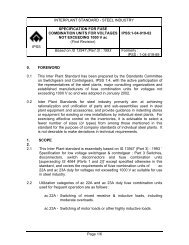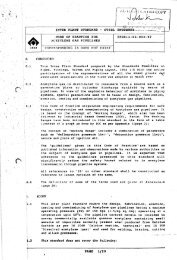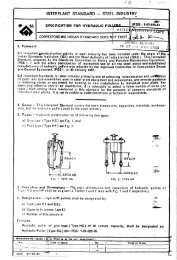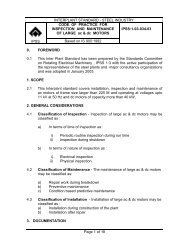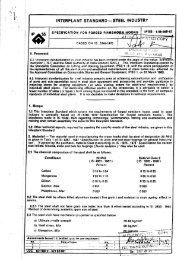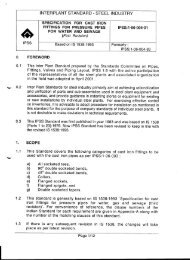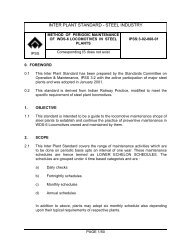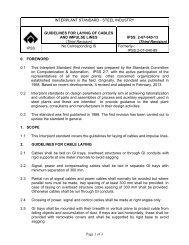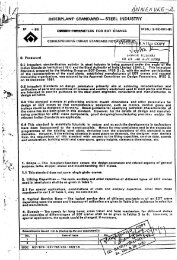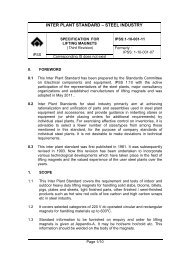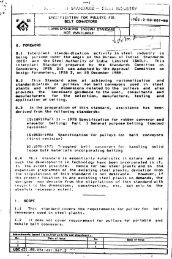Definition of terms relating to maintenance & equipment performance
Definition of terms relating to maintenance & equipment performance
Definition of terms relating to maintenance & equipment performance
Create successful ePaper yourself
Turn your PDF publications into a flip-book with our unique Google optimized e-Paper software.
IPSS<br />
0. FOREWORD<br />
INTER PLANT STANDARD - STEEL INDUSTRY<br />
DEFINITION OF TERMS RELATING TO<br />
MAINTENANCE & EQUIPMENT<br />
PERFORMANCE (First Revision)<br />
Corresponding IS does not exist<br />
IPSS : 3-02-006-07<br />
Formerly:<br />
IPSS:3-02-006-00<br />
0.1 This Inter Plant Standard has been prepared by the Standards Committee<br />
on Operation & Maintenance, IPSS 3:2 with the active participation <strong>of</strong> major<br />
steel plants and was adopted in March 2007.<br />
0.2 With the growing emphasis on adoption <strong>of</strong> quality system as per ISO 9000<br />
series <strong>of</strong> standards, IPSS 3:2 has felt the necessity for having <strong>terms</strong> <strong>relating</strong><br />
<strong>to</strong> <strong>maintenance</strong> & <strong>equipment</strong> <strong>performance</strong> properly defined <strong>to</strong> avoid any<br />
ambiguity <strong>of</strong> meaning and hence this standard.<br />
0.3 These definitions are generally relevant <strong>to</strong> SAIL plants & units.<br />
0.4 As per practice, Standard was reviewed and updated.<br />
1. SCOPE<br />
1.1 This standard covers definitions <strong>of</strong> <strong>terms</strong> <strong>relating</strong> <strong>to</strong> <strong>maintenance</strong> &<br />
<strong>equipment</strong> <strong>performance</strong>.<br />
2. DEFINITIONS<br />
2.1 ASSEMBLY - An assembly is an orderly combination <strong>of</strong> individual<br />
parts/sub-assemblies, which can perform desired function.<br />
2.2 ASSET - An asset is Capital Item, which can independently by itself<br />
produce goods or render services. An asset is not a spare item and can<br />
render its service anywhere without reference <strong>to</strong> particular <strong>equipment</strong>.<br />
2.3 ATTACHMENT & ACCESSORIES - An attachment or an accessory does<br />
not necessarily form a spare part <strong>of</strong> <strong>equipment</strong> but enhances the<br />
<strong>performance</strong>s <strong>of</strong> the <strong>equipment</strong> when these are added on.<br />
2.4 AVAILABLE HOURS- Installed calendar hours minus planned repair hours.<br />
2.5 BREAKDOWN - Any unplanned s<strong>to</strong>ppage <strong>of</strong> <strong>equipment</strong>/mechanism due <strong>to</strong><br />
damage <strong>to</strong> the <strong>equipment</strong> or system resulting in its inability <strong>to</strong> perform its<br />
function.<br />
Page 1/6
IPSS:3-02-006-07<br />
2.6 BREAKDOWN MAINTENANCE - The <strong>maintenance</strong> carried out on an<br />
<strong>equipment</strong> when it has already failed <strong>to</strong> perform its intended or desired<br />
function.<br />
2.7 COMPLETE UNIT - A complete unit is an <strong>equipment</strong> which can produce<br />
goods or render service but can be used a spare part <strong>of</strong> larger installations<br />
(pumps, compressors, mo<strong>to</strong>rs, genera<strong>to</strong>rs, cylinders, transformers etc.)<br />
2.8 CONSUMABLE - A consumable is an item which is required for the<br />
production process but does not form part <strong>of</strong> the end product.<br />
2.9 CONDITION BASED MAINTENANCE SYSTEM - In this technique, the<br />
<strong>maintenance</strong> is carried out depending on actual condition <strong>of</strong> <strong>equipment</strong> <strong>to</strong><br />
avoid failures. The condition <strong>of</strong> <strong>equipment</strong> is assessed and predicted after<br />
checking by the application <strong>of</strong> any one or combination <strong>of</strong> following methods:<br />
a) Use <strong>of</strong> basic human senses<br />
b) Use <strong>of</strong> conventional primary instrument<br />
c) Application <strong>of</strong> sophisticated <strong>to</strong>ols<br />
d) Through product quality<br />
2.10 CAPITAL REPAIR - These are normally carried out once in a year or at<br />
higher interval <strong>to</strong> bring back the <strong>equipment</strong> / unit <strong>to</strong> normal. The repair cost,<br />
and cost <strong>of</strong> spares are capitalized.<br />
2.11 CHECKING - Checking is a short time activity <strong>to</strong> find out and assess the<br />
condition <strong>of</strong> <strong>equipment</strong> either with the help <strong>of</strong> human senses or aided with<br />
small <strong>to</strong>ols and is carried out on <strong>equipment</strong> either in running condition or<br />
idle condition.<br />
2.12 DESIGN OUT MAINTENANCE - When the failure <strong>of</strong> the same nature is<br />
taking place again and again and no method <strong>of</strong> <strong>maintenance</strong> is able <strong>to</strong><br />
prevent failures, the <strong>equipment</strong> must be redesigned and it is known as<br />
design out/re-design <strong>maintenance</strong>.<br />
2.13 DELAY - Any unplanned s<strong>to</strong>ppage <strong>of</strong> <strong>equipment</strong>s or system affecting<br />
production is considered as delay.<br />
2.14 DESIGN DEFICIENCY - If the <strong>equipment</strong>s/sub-assembly fails quite<br />
frequently and is unable <strong>to</strong> perform under normal working condition, it is<br />
considered <strong>to</strong> have design deficiency.<br />
The lack <strong>of</strong> accessibility <strong>of</strong> the part <strong>of</strong> assembly for repairs, use <strong>of</strong> substandard<br />
material, low fac<strong>to</strong>r <strong>of</strong> safety in original design, ignorance <strong>of</strong><br />
design aspects and regular failure are some <strong>of</strong> the reasons for design<br />
deficiency.<br />
Page 2/6
IPSS:3-02-006-07<br />
2.15 FAILURE - Inability <strong>of</strong> an item or component <strong>to</strong> meet specified/intended<br />
function, when the <strong>performance</strong> <strong>of</strong> unit goes below the expected norms.<br />
2.16 INTERRUPTION - Interruption is a forced s<strong>to</strong>ppage <strong>of</strong> otherwise smoothly<br />
running system/production unit and is normally <strong>of</strong> short duration.<br />
2.17 INSPECTION - Inspection is an activity where the machine part or the<br />
<strong>equipment</strong> is examined closely and assessed for defects or deficiencies. It<br />
can be short term or long term. Checking falls under short term inspection.<br />
Long term inspection involves opening up the <strong>equipment</strong> and measuring<br />
various parameters.<br />
2.18 INSTALLED CALENDAR HOUR (ICH) - The no. <strong>of</strong> units multiplied by 24<br />
hours in a day are installed calendar hour for the day and similarly for<br />
month & year.<br />
2.19 JIGS & FIXTURES - A jigs is an enabling attachment for a machining<br />
operation which locates the points on work piece correctly and guides<br />
the <strong>to</strong>ol <strong>to</strong> perform the machining operation. It restricts the degrees <strong>of</strong><br />
freedom <strong>of</strong> an operating <strong>to</strong>ol and work piece.<br />
A fixture is an enabling attachment which locates the reference point on a<br />
workpiece and limits its degree <strong>of</strong> freedom.<br />
2.20 LIFE CYCLE TIME – This is the <strong>to</strong>tal period from commissioning <strong>of</strong> an<br />
<strong>equipment</strong> till it has given its full functional life.<br />
2.21 MAINTENANCE – Any action taken <strong>to</strong> keep/res<strong>to</strong>re <strong>equipment</strong> or system in<br />
a condition <strong>to</strong> perform its intended or desired function is termed as<br />
Maintenance.<br />
2.22 MAJOR REPAIR – This is defined where the duration exceeds 3 shifts but<br />
less than 6 shifts and is not a capital repair.<br />
2.23 MAINTENANCE DELAY – Any unplanned s<strong>to</strong>ppage <strong>of</strong> <strong>equipment</strong>s or<br />
system affecting production due <strong>to</strong> the failure <strong>of</strong> the <strong>equipment</strong>, system is<br />
mechanical delay. If it is a mechanical failure it is treated as <strong>maintenance</strong><br />
delay and if failure is electrical it is considered as electrical delay.<br />
2.24 OPERATION DELAY – Operation delay is the delay due <strong>to</strong> Operational<br />
agency affecting production and includes delays are non-availability <strong>of</strong> input<br />
materials, s<strong>to</strong>ppages <strong>of</strong> upstream facilities.<br />
2.25 PLANNED MAINTENANCE/SCHEDULED MAINTENANCE – The<br />
<strong>maintenance</strong> activities carried out with fore thought and control where all<br />
aspects <strong>of</strong> jobs are considered so that <strong>maintenance</strong> information, planning,<br />
special <strong>to</strong>ols & tackles and safety <strong>of</strong> the job are taken care <strong>of</strong>, feedback <strong>of</strong><br />
the action taken and his<strong>to</strong>ry records forms an integral and essential part <strong>of</strong><br />
planned <strong>maintenance</strong>.<br />
Page 3/6
IPSS:3-02-006-07<br />
2.26 RUNNING MAINTENANCE – It is a form <strong>of</strong> preventive <strong>maintenance</strong> carried<br />
out while the plant or <strong>equipment</strong> is continuing <strong>to</strong> perform its function. It<br />
involves activities such as inspection, tightening the bolts, cleaning,<br />
adjusting and lubrication. This can also be termed as “servicing”.<br />
2.27 REVAMPING - Revamping is an activity <strong>of</strong> capital repair nature wherein<br />
complete assemblies & sub-assemblies <strong>of</strong> an <strong>equipment</strong> are not only<br />
changed but also new accessories and attachments are added <strong>to</strong> improve<br />
<strong>performance</strong> <strong>of</strong> the <strong>equipment</strong>.<br />
2.28 REBUILDING - Rebuilding as applied <strong>to</strong> steel industry generally refers <strong>to</strong><br />
Rebuilding <strong>of</strong> Coke Oven Batteries. This involves complete dismantling &<br />
demolishing <strong>of</strong> the Oven structures above foundation and rebuilding <strong>of</strong><br />
entire new battery with its civil, structural and refrac<strong>to</strong>ry works.<br />
2.29 RELINING - It applies <strong>to</strong> relining <strong>of</strong> the Blast Furnaces, Hot Metal Mixer,<br />
Open Hearth & Twin Hearth Furnaces, LD Converters, Soaking Pits and<br />
Ladles. Relining involves complete dismantling <strong>of</strong> old worn out refrac<strong>to</strong>ry<br />
lining and putting new lining in its place.<br />
2.30 RELIABILITY CENTRAL MAINTENANCE (RCM) - RCM is an integrated<br />
<strong>maintenance</strong> strategy which determines <strong>maintenance</strong> requirement <strong>of</strong> each<br />
item <strong>of</strong> <strong>equipment</strong>s in its operating context. It recognizes that all the<br />
possible approach <strong>to</strong> <strong>maintenance</strong> have part <strong>to</strong> play in modern<br />
<strong>maintenance</strong> system. By taking consequences <strong>of</strong> failure in<strong>to</strong> consideration it<br />
helps in selecting the most appropriate <strong>maintenance</strong> strategy for any given<br />
situation.<br />
2.31 SUB-ASSEMBLY - A Sub-assembly is an orderly combination <strong>of</strong> individual<br />
parts which can be used as replacement as a unit.<br />
2.32 SHUTDOWN MAINTENANCE - It is <strong>of</strong>ten both preventive and corrective<br />
work which is normally implemented when plant or <strong>equipment</strong> is taken out<br />
<strong>of</strong> service specifically for <strong>maintenance</strong>.<br />
2.33 SPARES - A spare <strong>of</strong> an <strong>equipment</strong> is a single part or sub-assembly<br />
subjected <strong>to</strong> wear and can be replaced by another identical single part or<br />
sub-assembly which res<strong>to</strong>res the <strong>equipment</strong>'s normal function. A spare is a<br />
revenue item. A spare by itself can not serve any useful function.<br />
2.34 TIME BASED MAINTENANCE - Replacement or repair at a fixed time<br />
interval before failure is known is time based <strong>maintenance</strong>.<br />
2.35 TOTAL DELAY - Total delay is sum <strong>of</strong> all delays due <strong>to</strong> various agencies<br />
like operation, <strong>maintenance</strong> and services.<br />
Page 4/6
MAINTENANCE INDICES<br />
IPSS:3-02-006-07<br />
2.38A GROSS EQUIPMENT AVAILABILITY<br />
Installed Calendar Hours - Planned Repair Hours<br />
________________________________________ x 100<br />
Installed Calendar Hours<br />
2.38B NET EQUIPMENT AVAILABILITY<br />
ICH - (Planned + Unplanned Repairs in Hours)<br />
________________________________________ x 100<br />
Installed Calendar Hours (ICH)<br />
2.39 EQUIPMENT UTILIZATION<br />
ICH - (Planned Repairs + Total Delays)<br />
________________________________________ x 100<br />
Installed Calendar Hours<br />
2.40 INSPECTION INDEX<br />
No. <strong>of</strong> Inspections carried out<br />
______________________________ x 100<br />
No. <strong>of</strong> inspections planned<br />
2.41 JOB FULFILLMENT<br />
No. <strong>of</strong> jobs fulfilled<br />
____________________ x 100<br />
No. <strong>of</strong> jobs planned<br />
2.42 CAPITAL REPAIR FULFILLMENT EFFECTIVENESS<br />
No. <strong>of</strong> jobs actually done Job days planned<br />
_________________________ x __________________<br />
No. <strong>of</strong> jobs planned Job days actual<br />
2.43 EMERGENCY WORK RATIO<br />
Man hours spent on unplanned <strong>maintenance</strong><br />
____________________________________<br />
Man hours spent on <strong>to</strong>tal <strong>maintenance</strong> jobs<br />
2.44 EQUIPMENT FAILURE FREQUENCY<br />
No. <strong>of</strong> occurrences <strong>of</strong> <strong>maintenance</strong> delays<br />
______________________________________ x 100<br />
Page 5/6
Installed Calendar Hours<br />
IPSS:3-02-006-07<br />
2.45 EQUIPMENT FAILURE INTENSITY<br />
Maintenance delays in hours<br />
_________________________ x 100<br />
Installed Calendar Hours<br />
2.46 MEAN TIME BETWEEN FAILURES (MTBF) - It is the mean time between<br />
the occurrence <strong>of</strong> consecutive faults or failures and is a measure <strong>of</strong><br />
functional reliability.<br />
2.47 MEAN TIME TO FAILURE (MTTF) - It is the average time from conclusion<br />
<strong>of</strong> work <strong>to</strong> rectify a fault until the next fault occurs. It is also a measure <strong>of</strong><br />
functional reliability.<br />
2.48 MEAN TIME TO REPAIR (MTTR) - It is the mean time <strong>to</strong> repair and is a<br />
measure <strong>of</strong> <strong>equipment</strong> maintainability.<br />
2.49 MAINTENANCE COST<br />
Elements:<br />
1. Spares consumption (purchase + in-house manufactured)<br />
2. Labour Cost (Department + Contractual)<br />
3. Cost <strong>of</strong> consumables & s<strong>to</strong>res<br />
4. Cost <strong>of</strong> services<br />
_______________<br />
Page 6/6




